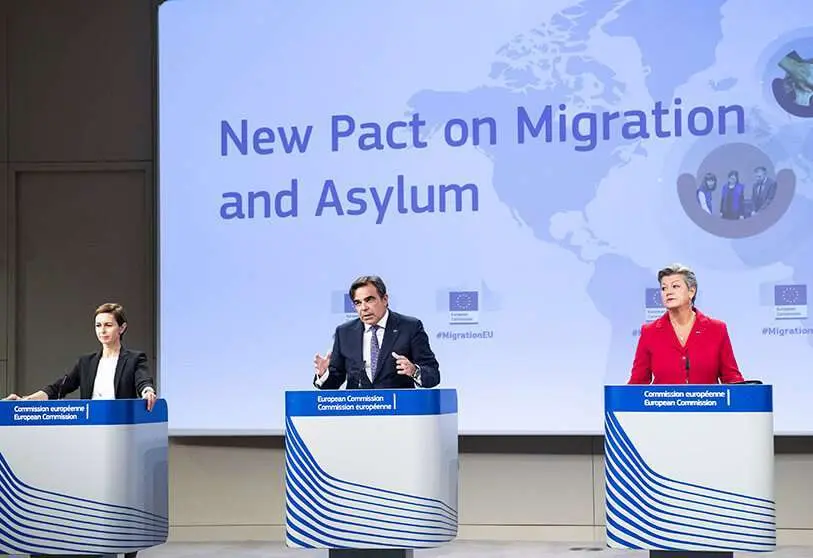About the EU Pact on Migration and Asylum

Last September 23rd the European Commission, chaired by Ursula von der Leyen, made public the Pact on Migration and Asylum, a document that sets out policy lines and proposes legislative changes with the aim of redirecting an issue that raises very different opinions and points of view among the Member States of the European Union, which are often difficult to reconcile. The Pact forms part of one of the six priorities of the new European Commission, which is concerned with promoting the European way of life.
The purpose of the new Commission has been to present a document to the Member States for political discussion. The initial situation is complex: on the one hand, there is a clear lack of consensus on migration issues between the Visegrad Group (Hungary, Poland, Slovakia and the Czech Republic) and the rest; on the other hand, there is also a certain amount of mistrust between the countries of the north and south of the Union regarding the fulfilment of obligations in migration issues. The Commission's proposal is that the debate, which is often more emotional than intellectual, should be redirected towards political negotiation. In this respect, the proposed document should be seen as a starting point.
With all the constraints imposed by the political context, the resulting document proposes a minimum of content to enable the Member States to get started on this controversial issue. This is why the Pact has been a disappointment for many European actors - particularly those most involved in improving the conditions of migrants arriving in Europe - because of their lack of ambition in establishing a real migration policy based on the values on which the European Union is founded.
The contents of the Pact refer to three areas of action: external (cooperation with third states); the border (management of the EU's borders); and internal (legal migration and inclusion policies). Although it is very difficult to summarise in a few lines all the aspects included in the document, we offer below a summary of the proposals that seem most relevant to us:
In the external sphere there is a commitment to cooperate with third States. In the case of the African continent, for example, understanding with the African Union is strengthened (without detriment to the recognition that the migratory context of each country is different, and that the EU must be sensitive to these differences). Economic aid to countries of origin is promoted to weaken the reasons that lead African citizens to emigrate (which for the EU are fundamentally demographic and economic). It is implicitly and explicitly assumed that development aid is a key factor in reducing migratory flows (even though some studies show that there is no exact correspondence between migration and poverty).
Border management includes various initiatives: a security, health and identity screening is proposed at the borders, which determines which migrants can receive asylum and which must be returned to their countries of origin. In this process, the fundamental rights of all persons concerned are guaranteed. The entire border procedure should take a maximum of 12 weeks. In addition, the Eurodac database is strengthened to become a tool to help manage migration, not just asylum. The figure of the European Returns Coordinator is also created, as well as a European Asylum Agency.
The Pact also devotes a section to rescue and salvage operations at sea, which makes explicit the rejection of the criminalisation of NGOs and other actors who carry out search and rescue operations in compliance with the law.
As far as the intra-community level is concerned, the proposal speaks of constant solidarity between the Member States: for example, it avoids overloading the countries in the front line but, at the same time, renounces imposing obligatory quotas of migrants on the different States; in this last aspect, it highlights the financing of returns: a Member State "sponsors" the return to a country with which it has a good relationship (so, for example, if a country like France has a good relationship with Afghanistan, that country can manage the return of Afghan migrants who have arrived on the Greek or Cypriot coasts, and who remain there until their return is resolved)
By way of conclusion, taking into account the opinions and analyses raised by the Pact over the past month, we can say that the assessments of the organisations of the third social sector agree that the Commission has given more importance to aspects focused on security, to the detriment of considerations relating to the integration of migrants in the host societies.
The Commission, for its part, points out that this is a coherent set of measures which respects the values on which the European Union is founded (e.g. respect for personal dignity in the asylum-seeking and return processes) and aims to create the conditions for political discussion between Member States to replace unsupportive and non-consensual initiatives.
Luis Guerra, Professor of Spanish Language at the European University of Madrid, is one of the main researchers of the INMIGRA3-CM project, financed by the Community of Madrid and the European Social Fund

